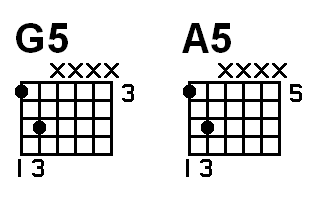Lesson Goals:
♦ Learn the proper fingering for the G5 & A5 chords
♦ Review the A major chord in the open position
♦ Play both versions of "You Really Got Me" Intro
This well known opening riff for the Kinks classic "You Really Got Me" is fairly easy.
We are going to show you two different ways to play the opening riff. The first is the way it was played on the Kinks version, and then we will show you the riff like it was played in the Van Halen re-make of the song.
Let's first take a look at the chord diagrams for the G5 and A5 chords. If you are unfamiliar with chord diagrams please see "Reading Chord Diagrams". Both of these chords are simple two note chord formations.

The G5 is formed by placing the 1st finger on the 3rd fret of the 6th string and the 3rd finger on the 5th fret of the 5th string. If you are unfamiliar with the string numbers please see "Naming the Open Strings".
The pattern or shape of the A5 chord is identical to the fingering pattern of the G5, except that it is played two frets higher than the G5.
In this case, the A5 is formed by placing the 1st finger on the 5th fret of the 6th string, and the 3rd finger on the 7th fret of the 5th string.
Look at the TAB below for playing the Kinks version of the opening riff. If you are unfamiliar with reading TAB please see our tutorial titled "How to Read TAB".

The riff opens with one beat on the G5, then two beats on the A5, then one beat on the G5, and finishes with one beat on the A5.
Now take a look at the TAB below for the Van Halen version of the opening riff.

This version is based around the A major chord in the open position.
This easiest way to play this version is to form an A chord using the one finger method, where your 1st finger covers the notes on the 2nd fret of the 2nd, 3rd and 4th strings.
Staying planted in the A chord position, you will then use your 2nd finger to reach to the 3rd fret of the 6th string and do a string bend. While you are at the top end of the bend, you strike the A chord.
When the bend is made, you are going from a G note (3rd fret of the 6th string) and bending up to an A note. When the bend reaches the A note, then you strike the A chord, which the bended note then naturally resolves too.
It's a lot easier to play than to describe. Give it a try!
Enjoy...
![]()
